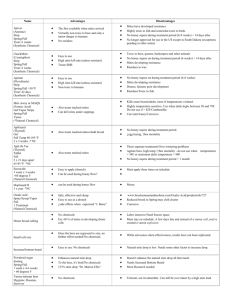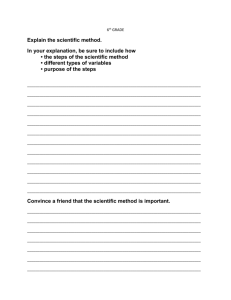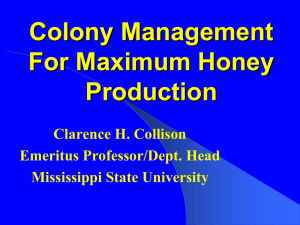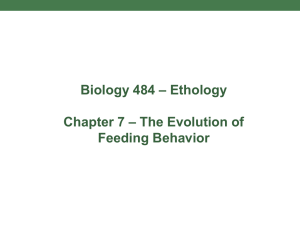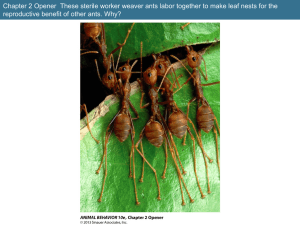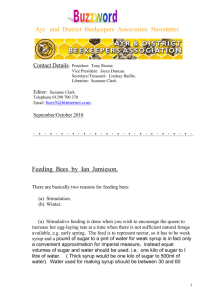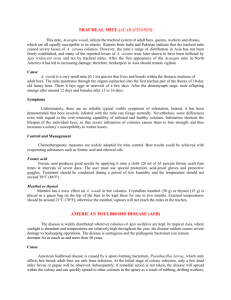July Tips Please click for details
advertisement
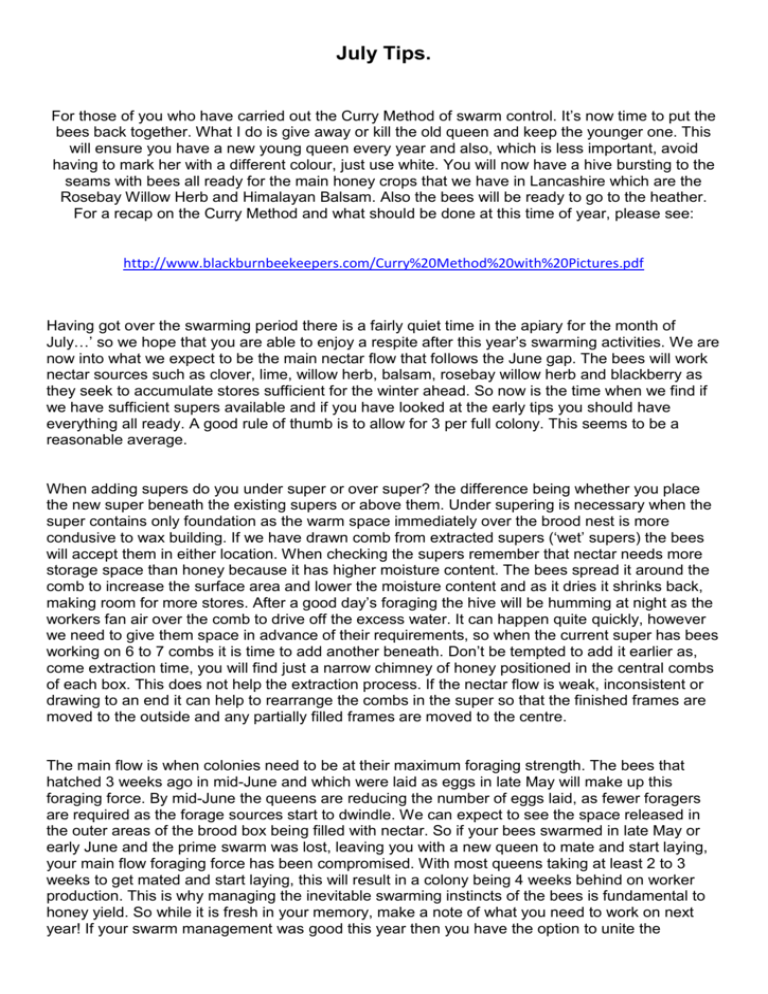
July Tips. For those of you who have carried out the Curry Method of swarm control. It’s now time to put the bees back together. What I do is give away or kill the old queen and keep the younger one. This will ensure you have a new young queen every year and also, which is less important, avoid having to mark her with a different colour, just use white. You will now have a hive bursting to the seams with bees all ready for the main honey crops that we have in Lancashire which are the Rosebay Willow Herb and Himalayan Balsam. Also the bees will be ready to go to the heather. For a recap on the Curry Method and what should be done at this time of year, please see: http://www.blackburnbeekeepers.com/Curry%20Method%20with%20Pictures.pdf Having got over the swarming period there is a fairly quiet time in the apiary for the month of July…’ so we hope that you are able to enjoy a respite after this year’s swarming activities. We are now into what we expect to be the main nectar flow that follows the June gap. The bees will work nectar sources such as clover, lime, willow herb, balsam, rosebay willow herb and blackberry as they seek to accumulate stores sufficient for the winter ahead. So now is the time when we find if we have sufficient supers available and if you have looked at the early tips you should have everything all ready. A good rule of thumb is to allow for 3 per full colony. This seems to be a reasonable average. When adding supers do you under super or over super? the difference being whether you place the new super beneath the existing supers or above them. Under supering is necessary when the super contains only foundation as the warm space immediately over the brood nest is more condusive to wax building. If we have drawn comb from extracted supers (‘wet’ supers) the bees will accept them in either location. When checking the supers remember that nectar needs more storage space than honey because it has higher moisture content. The bees spread it around the comb to increase the surface area and lower the moisture content and as it dries it shrinks back, making room for more stores. After a good day’s foraging the hive will be humming at night as the workers fan air over the comb to drive off the excess water. It can happen quite quickly, however we need to give them space in advance of their requirements, so when the current super has bees working on 6 to 7 combs it is time to add another beneath. Don’t be tempted to add it earlier as, come extraction time, you will find just a narrow chimney of honey positioned in the central combs of each box. This does not help the extraction process. If the nectar flow is weak, inconsistent or drawing to an end it can help to rearrange the combs in the super so that the finished frames are moved to the outside and any partially filled frames are moved to the centre. The main flow is when colonies need to be at their maximum foraging strength. The bees that hatched 3 weeks ago in mid-June and which were laid as eggs in late May will make up this foraging force. By mid-June the queens are reducing the number of eggs laid, as fewer foragers are required as the forage sources start to dwindle. We can expect to see the space released in the outer areas of the brood box being filled with nectar. So if your bees swarmed in late May or early June and the prime swarm was lost, leaving you with a new queen to mate and start laying, your main flow foraging force has been compromised. With most queens taking at least 2 to 3 weeks to get mated and start laying, this will result in a colony being 4 weeks behind on worker production. This is why managing the inevitable swarming instincts of the bees is fundamental to honey yield. So while it is fresh in your memory, make a note of what you need to work on next year! If your swarm management was good this year then you have the option to unite the colonies that resulted from your artificial swarms to create the strong foraging force. Normal practice is to keep the queen from this year rather than the old queen. Another consequence of the reduction in egg laying is the reduction in cells that the Varroa mite can reproduce in. If there are large numbers of mite in the colony they will be crowded into fewer and fewer cells, resulting in multiple infestations per cell and more damage to the developing pupa. Varroa treatment options are limited while we have honey on the hive but come August when we remove the honey we need to take action. During July, check your mite levels in preparation. We use open mesh floors but this year we can try comparing those results with the mite count from the icing sugar roll test; (½ cup of bees taken from brood frame & rolled in a jar with 1 tblsp of icing sugar for 30 secs. The jar has a mesh lid so sugar and dislodged mites can be shaken out and mites counted. Shaking into a white bowl of water makes it easier to count them. Divide mite count by 3 to get % infestation, i.e. 36 mites = 12% infestation. Greater than 5% infestation needs treatment. Dazed bees can be released back to colony entrance). Other apiary tasks for July include: Recovering wax from old frames or brace comb bits in a solar extractor. Stuff them into a mesh bag first to act as a filter to retain the debris. Old tights are ideal! Bob Fulton as come up with a lot better method of rendering wax down and anyone who has attended his beekeeping classes will have seen him demonstrate this great way of going about it. Looking carefully at the honey coming in and noting which combs could have prize winning contents at this year’s honey shows. f you take your bees to the heather for their August treat they need to be being prepared at the end of July. Young queens, disease free stocks, large brood nests and cut comb wax in supers are some of the preparations. If you get the chance to take bees to the heather it can be a great experience, but there are no guarantees of success. As July comes to an end the wasps will be on the prowl looking for weak colonies to raid. Have narrow entrances ready to let the bees defend what they have. Wasp traps located a few metres from the apiary can also help keep numbers down. Be very careful of spilling any syrup that you may be using and in general keep things clean with no spillages as this will attract wasps from miles around. As usual, keep an eye out for colony health. Any colony not keeping up with its peers needs to be inspected to make sure it is queen-right and healthy. Requeen any colony with undesirable characteristics such as poor production, European foulbrood (not AFB), poor brood pattern, mean temper, etc. Queenless hives are a real problem and need to be either requeened with a nuc or retired. Typically, queenless hives have an abundance of pollen stored in multiple frames (no brood to feed). This condition typically is followed by the development of laying workers. Signs of laying workers are multiple eggs per cell, eggs on the side of cells (opposed to one egg centred on the bottom), and drone brood development in worker cells. If requeening, always place the nuc in the top brood box and to one side (easier to defend). You may want to reverse brood boxes first as there may be fewer bees in the lower box (again, easier to defend). If you retire the hive, shake the bees out and share the frames with other hives - the workers will perceive the eggs as foreign and unwanted and will eat them. After the drones hatch from the elongated worker cells, the workers will cut the cells back to their regular length. Keep on the lookout for American foulbrood as robbing season is imminent and AFB infected colonies make easy targets. AFB is highly infectious and early detection is important in its control. Remove and extract supers. Honey removed in late July/Early August will have less moisture content than honey in June, so you do not have to be as judicious about making sure that all cells are capped. Moreover, in late season the nectar flow can end, and the bees will be unable to cap the honey cells even though they are ready (sufficiently dehydrated). As a general rule you can always check the moisture content and ripeness of honey in a given frame by shaking it hard downward and seeing if nectar falls out. If a shower of nectar falls out, then that frame was not ready. Be prepared to do the most important treatments of the year for your hive in early August: Varroa mite treatment, and reducing hives down to winter configuration. Start to prepare your exhibits for the honey show, it may be a month early for the honey as that is extracted next month, but you can get other things ready such as wax craft exhibits, Photographic Print. Beeswax Candle, Mead Etc. I think that’s about it for July’s tips so have fun and get ready for August and the rewards for all your hard work over the year. THE HONEY Bob and Michael

